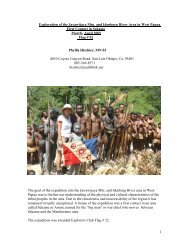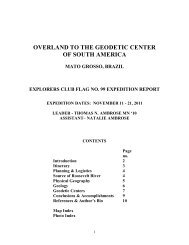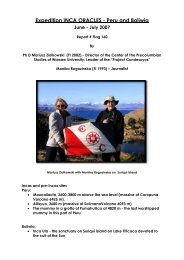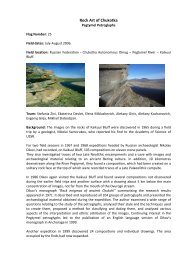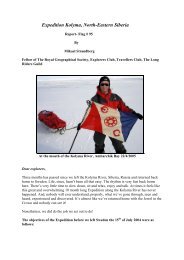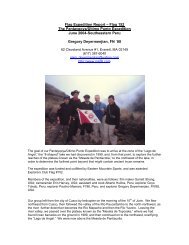the explorers journal the global adventure issue - The Explorers Club
the explorers journal the global adventure issue - The Explorers Club
the explorers journal the global adventure issue - The Explorers Club
- No tags were found...
Create successful ePaper yourself
Turn your PDF publications into a flip-book with our unique Google optimized e-Paper software.
An Illustration from Frank Leslie’s Illustrated Newspaper shows <strong>the</strong> dead being brought aboard <strong>the</strong> Bear in 1884In 1881, Greely and a group of 25 men establisheda frigid outpost <strong>the</strong>y named Fort Conger, just725 kilometers from <strong>the</strong> North Pole on EllesmereIsland. <strong>The</strong>y conducted scientific research andexploration as part of <strong>the</strong> first International PolarYear. When in 1883, a ship failed to appear tobring <strong>the</strong>m home, Greely and his men fell back ona pre-arranged plan to retreat 400 kilometers southalong <strong>the</strong> coast of Ellesmere to Cape Sabine onPim Island, where a year’s worth of supplies, if nota ship, was to await <strong>the</strong>m.<strong>The</strong> retreat south proved to be an agonizing,two-month ordeal over treacherous, moving ice.When Greely and his men finally arrived at CapeSabine in mid-October, <strong>the</strong>y were horrified to findnone of <strong>the</strong> promisedsupplies had been left.In preparation for <strong>the</strong>coming winter, <strong>the</strong>y constructeda stone house,which <strong>the</strong>y christenedCamp Clay. <strong>The</strong> monthsthat followed broughta descent into a frozenhell of starvation, madness,and suicide. Allbut one man managedto survive <strong>the</strong> winter,but with <strong>the</strong> coming ofspring <strong>the</strong> men began torapidly die of scurvy orstarvation. Unbelievably,two relief expeditionsorganized by <strong>the</strong> U.Sgovernment to re-supplyand <strong>the</strong>n retrieve <strong>the</strong> Greely expedition had failed,leaving <strong>the</strong> men’s fate unknown. When a navalrescue mission—instigated in part by a determinedHenrietta Greely and led by Commander WinfieldScott Schley—finally reached <strong>the</strong> men on June 22,1884, <strong>the</strong> few remaining members of Greely’sparty were within hours of death. Tragically, <strong>the</strong>world would soon learn that only Greely and six ofhis men had managed to survive.When <strong>the</strong> expedition returned to <strong>the</strong> UnitedStates on August 4, 1884, <strong>the</strong> survivors and<strong>the</strong>ir rescuers received a tumultuous receptionin Portsmouth, New Hampshire, very unlike <strong>the</strong>modest ceremony on “O” Street 50 years later.Greely’s men had not only completed <strong>the</strong>ir missionand brought back all of <strong>the</strong>ir data—includingmeteorlogical measurements, observations oftides, magnetism, and gravity, as well as biologicaland ethnological studies—<strong>the</strong>y had also claimed anew record for <strong>the</strong> fur<strong>the</strong>st north, which had beenheld by <strong>the</strong> British for 300 years.Within days of <strong>the</strong> joyous welcome home, however,ugly stories began to appear in <strong>the</strong> newspapers,alleging that <strong>the</strong> expedition’s dead had beencannibalized to support <strong>the</strong> living. Despite <strong>the</strong> factthat <strong>the</strong> rescuers had found at least six corpsesstripped of <strong>the</strong>ir flesh, <strong>the</strong> survivors, to <strong>the</strong> end of<strong>the</strong>ir days, denied any involvement. Greely’s onlycomment was, “I know no law of God or man thatwas broken at Cape Sabine.”Sadly, <strong>the</strong> Lady Franklin Bay Expedition’s heroicchapter in Arcticexploration slipped intoobscurity, clouded byaccusations of governmentincompetence,needless loss of life,and <strong>the</strong> ultimate taboo.During Greely’s lifetime,o<strong>the</strong>r polar <strong>explorers</strong>,particularly Robert E.Peary, avoided himand years later in 1961,Wilhjalmur Stefanssonrecalled that a hushwould fall wheneverGreely entered <strong>the</strong>room. <strong>The</strong> last livingperson to meet <strong>the</strong> general,Thaddeus Thorn,recalled him beingreferred to by <strong>the</strong> neighborhood boys as, “eat ‘emalive Greely.”So what is <strong>the</strong> real truth about this fascinating,accomplished man, who, among o<strong>the</strong>r things,served as <strong>the</strong> first president of <strong>The</strong> <strong>Explorers</strong><strong>Club</strong>? Should he be remembered as a hero, avictim, or a villain?<strong>The</strong>se were <strong>the</strong> questions that came to mindwhen I read Greely’s account, Three Years ofArctic Service, in preparation for a 1988 campingtrip with my wife and eldest son on <strong>the</strong> shores ofLake Hazen—<strong>the</strong> largest lake north of <strong>the</strong> ArcticCircle—which was some 80 kilometers northwestof Fort Conger. This story of heroism and villainy,personality conflicts, and coincidences, as well aspolitical shenanigans, seemed more like a work of<strong>the</strong> <strong>explorers</strong> <strong>journal</strong>



